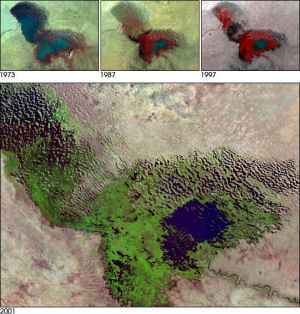2. Water Management
Water Shortage
In addition to the artificial reservoirs, water is also stored in natural repositories. Standing lake water has been used by people through the ages, almost as much as river water. However, changing environmental conditions cause changes to those natural reservoirs.
The borders of Lake Chad are split between four countries; Nigeria, Niger, Cameroon and predominantly Chad. Even though it is being fed by the Chari Riveer, it has always been a shallow lake. Currently it is supplying water to approximately 20 million people living around it, making it very important for the economy of those countries that surround it.
The lake's water level and boundaries have always been in flux, depending on the climatic conditions. At the beginning of the 20th century it almost dried out, only to expand to cover an area of 26,000 km2 and then shrink to a low 1,500 km2 in 2000.
The LANDSAT satellite images above, show the change in the boundaries and water level of Lake Chad from 1973 until 2001. The area that used to be occupied by water (appearing red in the 1973 - 1997 images and green in the 2001 image) are now used as agricultural land.
Another example is lake Poopo in Bolivia, on the Bolivian Andes. Because of it's elevation (3400 metres above sea level), small depth and the dry climate, even small amounts of percipitation can cause drastic changes to the water level of the lake. The two photrographs were taken in November 2006 and March 2006, from the crew of the International Space Station. The wet December to February period, has increased the water level in the lake, covering the salt flats on its north-west bank, and cutting off the land connection of the small island with the shore.


